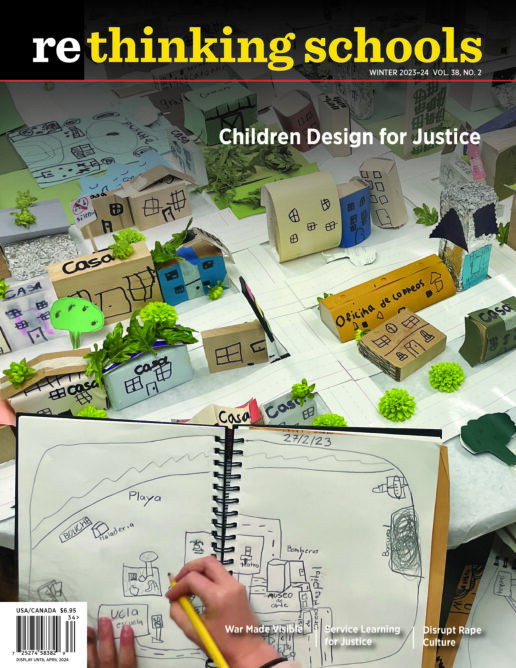Five Ways Textbooks Lie About Reconstruction
Illustrator: Howard Barry
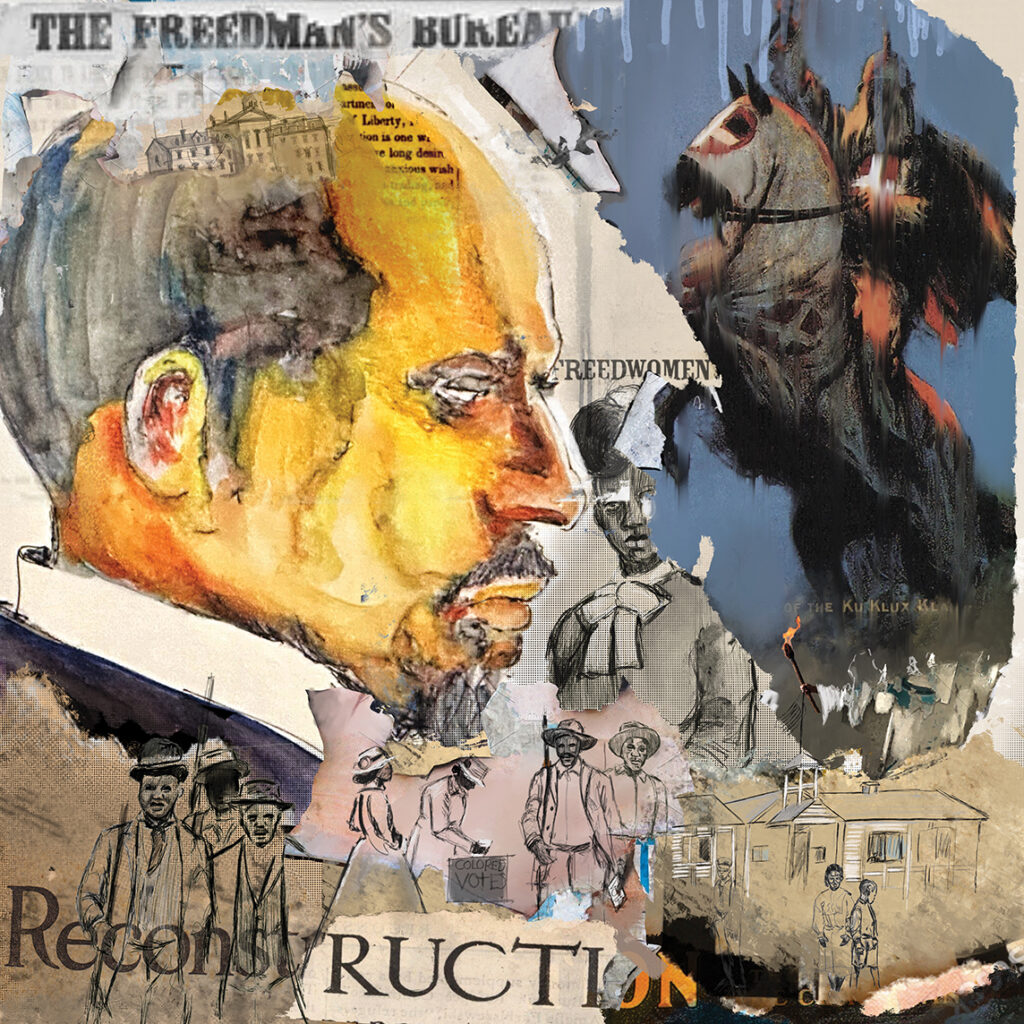
With “sufficient general agreement and determination among the dominant classes, the truth of history may be utterly distorted and contradicted and changed to any convenient fairy tale,” wrote the great scholar W. E. B. Du Bois in 1935, critiquing the Reconstruction “scholarship” of the Jim Crow era. “One cannot study Reconstruction without first frankly facing the facts of universal lying.”
In the era of emancipation, formerly enslaved people and their allies claimed political power once reserved for white elites, organized self-defense groups against white vigilantes, drafted new laws to redistribute wealth and extend civil rights, protested for better working conditions, founded school systems and won battles against segregation, built churches and mutual aid organizations, and advanced the possibilities of multiracial democracy by leaps and bounds. They challenged the levers of white supremacy across all areas of life and came closer than ever to dislodging them.
This was an era of extraordinary possibilities and progress for racial justice. But white supremacists responded with devastating campaigns against Black power and independence.
The consequences of Reconstruction and its undoing still ripple through structural disparities and justice movements today. When students learn this history, they can better understand the world they inherited and recognize their own roles in history-making. They can see that progress toward an equitable future — and against long-standing traditions of racial capitalism — is always hard-fought and won through grassroots activism and mutual care. They will know that freedoms are not guaranteed and must be championed and protected by each new generation.
But today, most textbooks omit these facts in favor of whitewashed myths — many of the same “fairy tales” Du Bois decried in 1935 — that promote the status quo and distance students from the lessons of history. Some reveal a celebratory spin right away, their covers emblazoned with titles like Becoming America, The American Journey, The American Pageant, or Understanding the American Promise. Most unfold their triumphs over several hundred pages, recounting U.S. history as a long victory march from enslavement to the myth of a post-racial present. The radical promise — and crushing — of Reconstruction shatters this narrative of steady progress. Textbooks warp the era accordingly.
In 2022, the Zinn Education Project released a report on Reconstruction’s place in social studies standards. Now, we offer a critique of how textbooks miss the mark in five ways:
1. Textbooks center Confederate states and ex-Confederates.
The Reconstruction section of Holt McDougal’s United States History: Beginnings to 1877 opens with a prompt: “If YOU were there . . .” The text urges students to imagine themselves as former Confederate soldiers traveling the South and witnessing, with dismay, the destruction of “plantation manor homes.” This narrative encourages students to view Reconstruction from the perspectives of those who fought to preserve enslavement. The main narrative begins below, introducing Reconstruction as the federal government’s “problem of dealing with the defeated southern states.”
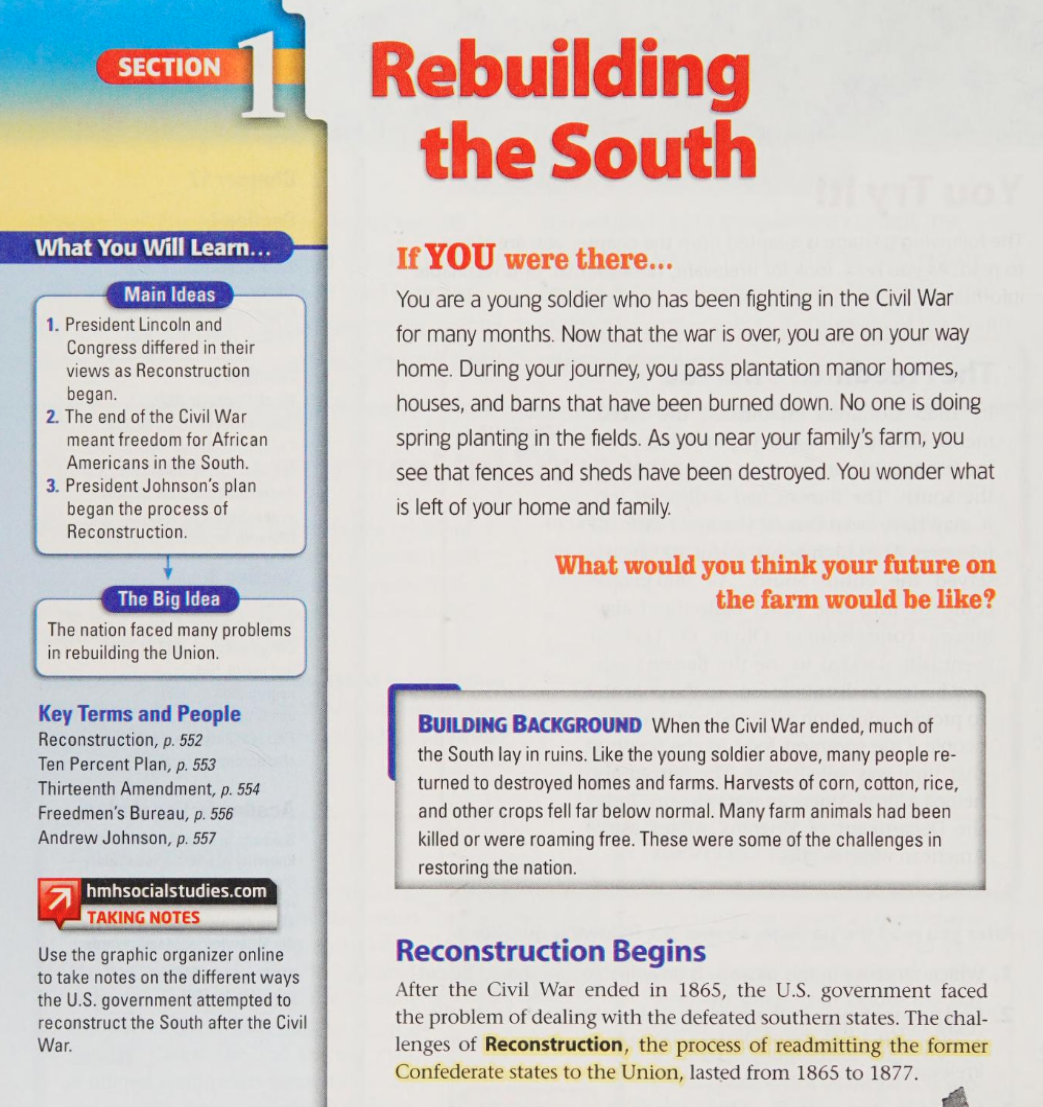
This page alone is a stark example of what most textbooks do, but shouldn’t: amplify discrete perspectives of white political figures and former soldiers in the aftermath of the Civil War. They narrow its focus, often establishing Reconstruction as a series of clashes between President Andrew Johnson and Congress to readmit the rebel states — or as the daunting task ahead of ex-Confederates to rebuild the war-torn South without slavery.
Meanwhile, as Lerone Bennett Jr. chronicled in Black Power U.S.A., “Black people were busy building institutions that were dangerous to the peace of biased white men.” They were ignoring orders from ex-Confederates; meeting in courthouses and fields to plan election strategies; gathering for picnics and parades; observing trials and debating legal issues; determining school subjects and teachers; establishing newspapers that brimmed with short stories, poetry, and advertisements for community events; and shaping the meaning of freedom in myriad other ways. But textbooks rarely characterize the 1860s by this rebuilding. They do not tell students that Reconstruction was a revolution to create a more just society from the ground up, or how many issues and movements today have roots in that struggle.
2. Textbooks treat white people as subjects and Black people as objects.
Textbooks often glorify white actors and dehumanize Black people, grounding their identities in enslavement. Prentice Hall’s United States History: Reconstruction to the Present, for instance, introduces “The Challenges of Reconstruction” as “How to Reunify the Union,” “How to Rebuild the Southern Economy,” and “How to Extend Citizenship to African Americans.” This language casts Black people as objects — of the economy, of the federal government, of certain white people — rather than subjects themselves and agents of freedom. This story’s protagonist is the federal government, which “struggled with how to return the 11 southern states to the Union, rebuild the South’s ruined economy, and promote the rights of former slaves.” Many textbooks spin a similar top-down tale, focusing on entire states or government institutions.
But change wasn’t handed down from the top. Freedpeople fought for it. They demanded the federal government exercise its economic, political, and legal reach for their rights and the greater good. Furthermore, the Southern economy was only “ruined” because it had been built on the backs of enslaved labor. And ruined for whom? Certainly not for the freedpeople who were able to accumulate wealth and own property for the first time. Without emphasizing the brutal and inhumane system of slavery, the focus on the “South’s ruined economy” seeks sympathy for former enslavers.
Across the era, textbooks tend to overemphasize white elites as Reconstruction’s key actors. The chapter in Perfection Learning’s Advanced Placement United States History — an ostensibly rigorous history of the era — devotes six painstaking pages to Abraham Lincoln, Andrew Johnson, Charles Sumner, and other white politicians in the business of Presidential and Congressional Reconstruction. It then consolidates the aspirations, activities, and achievements of formerly enslaved people into a one-page section titled “African Americans Adjusting to Freedom.” Here, students will find only a brief summary of freedpeople’s experiences and an incredible use of passive voice, which hides exactly who is denying freedom to Black people: “Having been so recently emancipated from slavery, they were faced with the challenges of securing their economic survival as well as their political rights as citizens.” The message is clear: White men in the halls of power make and debate societal changes, while Black people struggle with “challenges” that seem to come from nowhere.
3. Textbooks marginalize Black experiences and achievements rather than centering them as the main narrative.
In a fleeting acknowledgement of Black achievements, Perfection Learning’s Advanced Placement United States History provides a table to show increases in school enrollment from 1850 to 1880 and African American communities’ commitment to education. It fails to indicate, however, the scope of this commitment, which catalyzed the South’s first public school systems. Hundreds of thousands of African Americans sought to build schools and provide future generations with educational opportunities that they themselves were denied. The irony in how U.S. history textbooks neglect the origins of widely accessible formal education, among other things, should not be lost.
This is not unusual. Often, the minimal space textbooks grant to Black stories and achievements during Reconstruction appears like an afterthought — even at the start of a chapter. Pearson Education’s American Stories: A History of the United States, Volume 1 opens with a vignette about Black Civil War hero and Reconstruction-era politician Robert Smalls before shifting to its main narrative: “The Agony of Reconstruction” through the lens of white elites and their competing efforts to “reunite” the country.
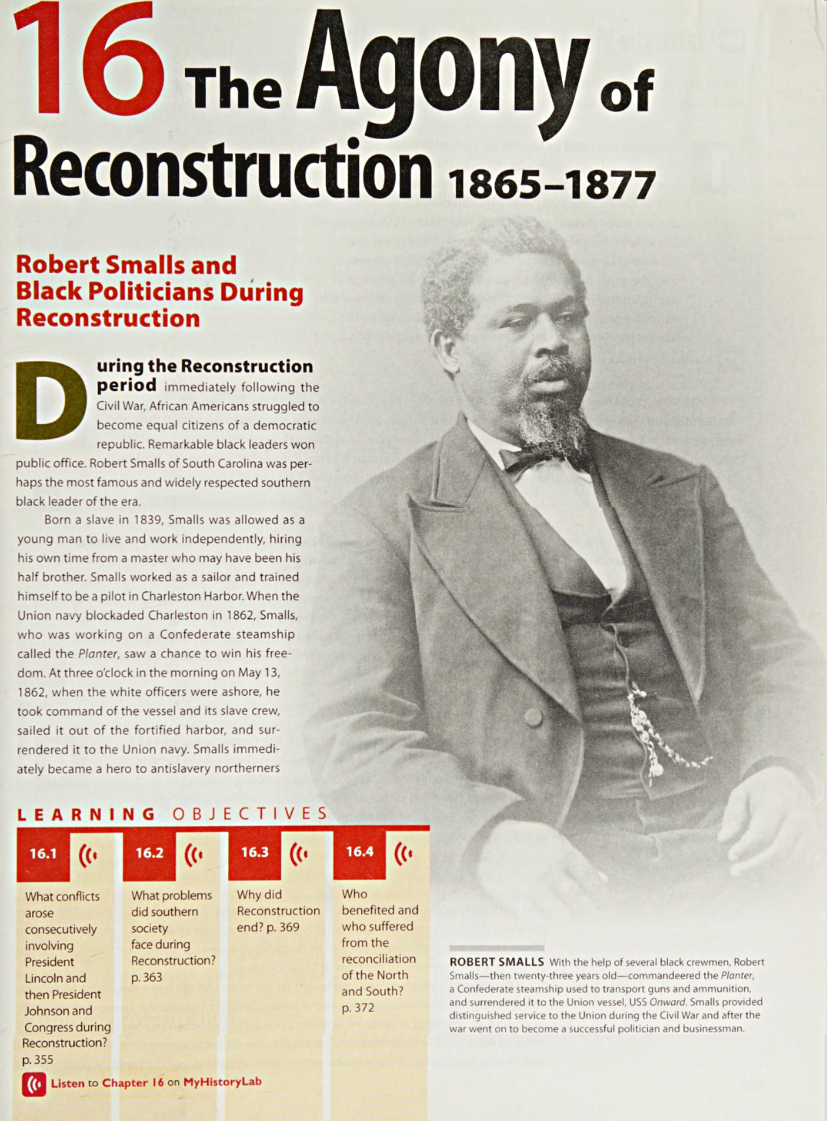
This all-too-common setup relegates Black people — even officeholders, like Smalls — to the margins, suggesting that their perspectives and activities are somehow separate and supplemental to the main narrative. Different colors and fonts often underscore this distinction. In appearance and implied importance, they set these pieces apart from the “required” reading.
4. Textbooks downplay the pervasiveness of white terror and fraud, distorting the role of the Ku Klux Klan in a much larger network of racial violence.
Take BVT Publishing’s Introduction to American History: Volume II, which introduces the Klan as a “playful” group established to “play practical jokes and serenade women.” The main narrative tells readers that this racial terror organization, though founded by a group of ex-Confederate soldiers, had nothing to do with racism or terror at the start — and devotes considerable space to the Klan’s “fun and games.” In staggering contrast to this rhetoric, the margin features the Klan’s lynching of a Black child. This is particularly egregious, but dozens of other textbooks trivialize the Klan and the oppressive systems for which it stands.
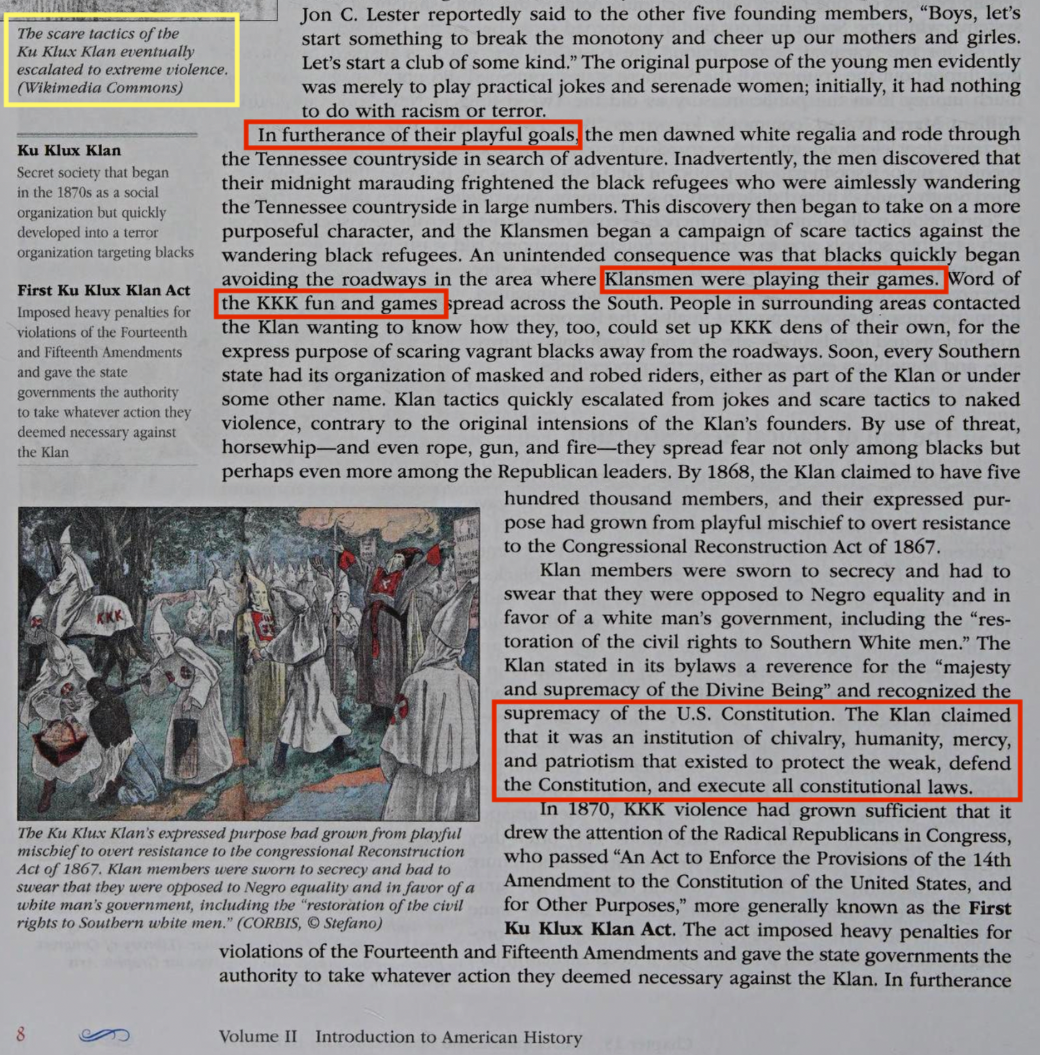
In an essay titled “The Cultural Work of the Ku-Klux Klan in U.S. History Textbooks, 1883–2015,” historian Elaine Frantz Parsons noted a tendency “to sensationalize the Klan as mysterious, entertaining, or beyond critical comprehension,” emphasizing that racial oppression itself is mysterious or unknowable, rather than evident and structural. In fact, the Klan and the Democratic Party of the 1860s and ’70s aligned to reinstate slavery, overlapping in methods and membership. These ties ran so deep that newspapers across the country reported “Ku-Klux Democracy” as shorthand for their joint assault on Reconstruction.
Klansmen targeted Black voters, officeholders, educators, landowners, and anyone else who represented even a semblance of racial equality. They razed Black churches and schools, centers of community and progress. The Klan aimed its attacks at destroying the solidarity that groups like the Union Leagues — multiracial Republican organizations that trained and nominated candidates and organized marches, often armed, to the polls — had built and maintained. To borrow historian Nell Painter’s phrase, the Klan became “the mercenary forces of the Democrats,” attempting to re-establish control for the wealthy white elite. As historian Steven Hahn points out, despite the “differences and variations” of Klan organization across the South, the “leaders generally had held rank in the [Confederate] army and were connected to families of local prominence.” But textbooks too often ignore the Klan as a force of counterrevolution and instead offer cartoonish images and flippant descriptions.
Even when textbooks do devote serious attention to the Klan, they overstate its role in a larger network of white supremacist violence and coercion. Rarely do textbooks contend with these larger and long-standing histories. Instead, they often suggest to readers that overt and effective white terror began and ended — neatly — with the Klan. But similar organizations like the White Leagues and the Knights of the White Camelia formed to terrorize freedpeople, and efforts to dismantle Reconstruction and stamp out multiracial democracy far transcended these groups. In the cover of night or broad daylight, white neighbors, employers, acquaintances, and Democratic Party officials carried out violence and fraud against Black people and their allies. In an interview about her new book I Saw Death Coming, historian Kidada Williams explained that white supremacist violence became so commonplace that young white children used the threat “If you don’t give me what I want, I’m going to have my family Ku Klux you.” This is why, although federal courts, including many Black jury members, prosecuted and helped disband this first generation of the Klan in the early 1870s, the backlash to Reconstruction did not end. It accelerated, as broader white supremacist action enshrined Jim Crow into law and practice.
At the turn of the century, shortly before the Klan’s resurgence, Progressive-era historians and textbook authors carved Klansmen into the national narrative of Reconstruction to naturalize and romanticize racial violence. As Parsons explains, channeling the fact of racial oppression through the figure of the Klan “suggested that postwar racial violence was unrelated to more proximate claims of oppression” and turned white terror “into a spectacle and a fascinating narrative rather than an enduring problem that demanded a political response.”
Public interest in the Klan has fluctuated since then, as have competing depictions of its role in Reconstruction’s demise — from tragically necessary, to celebratory, to subversive, to disgraceful. But the Klan’s sensational, larger-than-life space in U.S. history textbooks remains stable, shrouding and strengthening other forces of racial injustice. To be sure, the Klan’s activities are key to understanding Reconstruction — but only if they do not eclipse the rest of the story. It is telling that Du Bois’ classic work on the post–Civil War era and the state of U.S. democracy, Black Reconstruction in America, spends only a dozen or so of its 737 pages on Klan violence.
5. Textbooks ask if Reconstruction was a success or failure, obscuring the white supremacist counterrevolution that cut short its historic gains.
This dichotomy contributes to an incoherent but insistent closeout exercise in many textbooks: asking students to weigh the “successes” and “failures” of Reconstruction and make a final verdict on its legacy. Holt McDougal’s The Americans presents students with a point and counterpoint graphic organizer. Its “success” column summarizes major triumphs from the era, like increasing Black political representation, strides in public education, and the Reconstruction Amendments that first grounded the Constitution in equal treatment under the law.
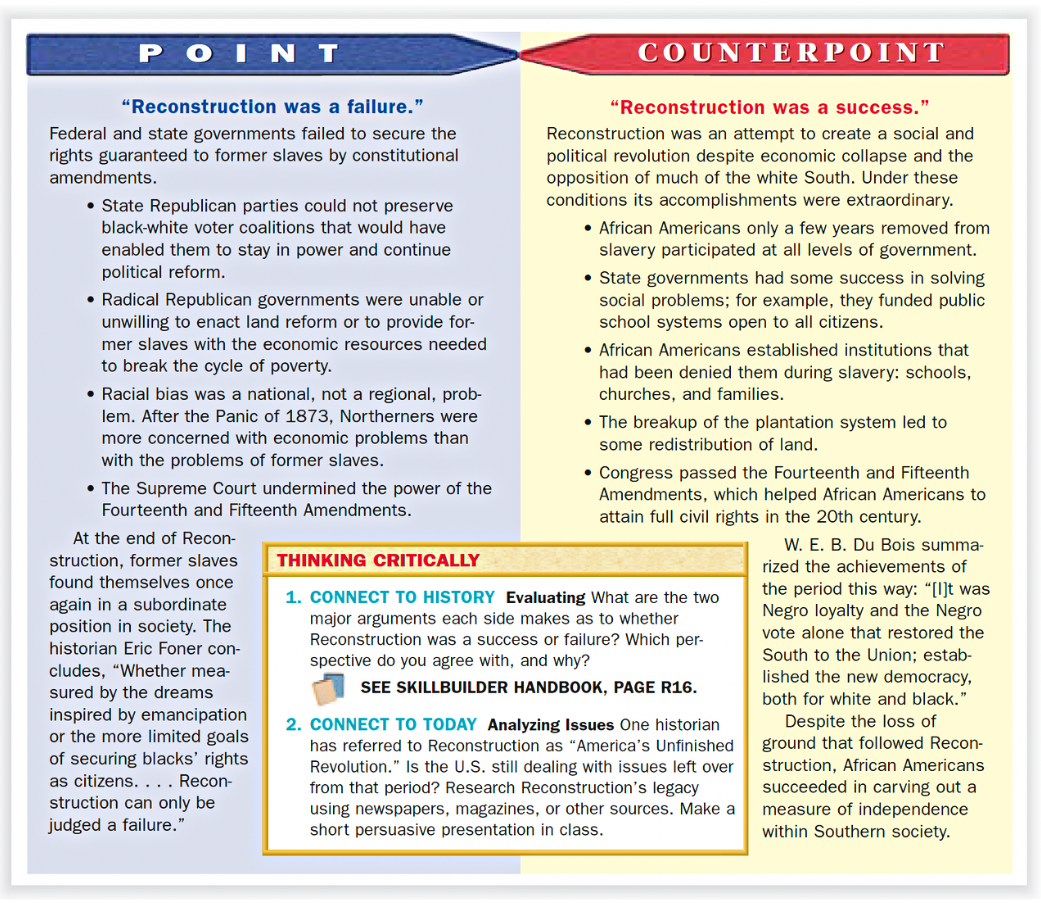
Its “failure” column, however, pins the end of Reconstruction on government alone. It suggests, correctly, that many white political leaders retreated from Reconstruction, but does not explain that they dissolved alliances with freedpeople to suit their shifting economic interests. It names an abstract, difficult-to-break “cycle of poverty”— overlooking poverty’s roots in centuries of slavery, capitalism, and intergenerational exploitation. In this “failure” calculus there is no real struggle, no white terror campaign to roll back progress. There is simply “racial bias” and vaguely incapable or unwilling federal and state institutions. At the end of Reconstruction, this column argues, “former slaves found themselves once again in a subordinate position in society.” Here, “failure” ascribes a sort of passive inevitability to the violent, structural overthrow of a racial justice movement that would reverberate in laws, institutions, and everyday life for generations. The “found themselves” language hides those responsible for Black people’s oppression.
Most “success vs. failure” framings do something similar: They oversimplify people’s actions and separate them from history’s outcomes. Cengage Learning’s HIST. Volume 2: U.S. History Since 1865 prompts students to agree or disagree, on a scale of 1 to 7, that Reconstruction was a failure. What does each number mean? For whom was Reconstruction a failure? For whom was it a success? And for whom would this exercise be useful?
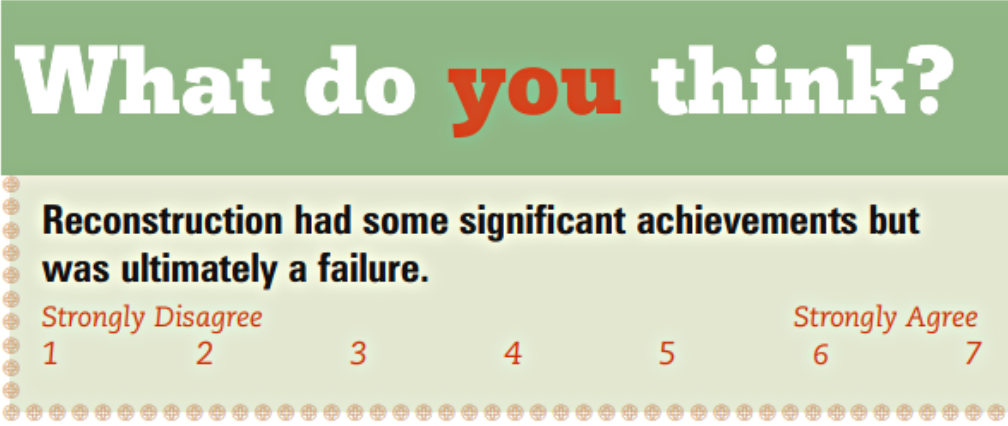
Even worse, many textbooks deem Reconstruction a failure outright, and without question — as if its legacy is nothing more than an inevitable plot point between the Civil War and Jim Crow on a long straight line toward progress. According to Cengage Learning’s American Passages, addressing inequities born from centuries of enslavement would have required “an expansion of national government power to an extent far beyond what Americans believed was justified” in the 1860s and ’70s. One wonders who counts as “Americans” here, when millions of people during Reconstruction — and millions of people today — put justice above “justifying” further oppression.
* * *
Textbooks so often steep in the master narratives of racial capitalism while also appearing objective and authoritative. They imagine young people as consumers, not decision makers. In matter-of-fact tones, they tell students what to care about, what to ignore, and who to memorialize. They gesture to who gets empathy in this country. And they insist that the course of history is inevitable, stifling the profound possibilities and questions we should all consider, like: What kind of country would we live in today if we’d had a true, lasting reconstruction of the United States after the Civil War? Where would we be now if this reckoning — this movement to build a society grounded in freedom and justice — had been crystallized, not torched?
We can learn a lot from textbooks if we read against the grain — that is, when we identify and question what Du Bois called the “convenient fairy tale” that masquerades as official history. Young people are capable of that and deserving of much more than the passive, misleading stories textbooks offer. With teaching materials that center active engagement in the lessons of Reconstruction, students can delve into primary sources and piece together narratives. They can debate and strategize about big questions of the time. They can envision revolutionary struggles to turn freedom from an abstract idea into a lived reality. And, most importantly, they can see themselves in history and make choices that drive justice today.
RESOURCES
Below is a brief list of resources for teaching Reconstruction outside the textbook. Find more at TeachReconstructionReport.org
Reconstructing the South: A Role Play
A role play engages students in thinking about what freedpeople needed in order to achieve — and sustain — real freedom following the Civil War.
Reconstructing the South: What Really Happened
A follow-up lesson to “Reconstructing the South” uses dozens of primary sources to reveal key outcomes of the Reconstruction era.
“40 Acres and a Mule: Role-Playing What Reconstruction Could Have Been”
A multimedia, creative role play introduces students to the ways African American life changed immediately after the Civil War by focusing on the Sea Islands before and during Reconstruction.
When the Impossible Suddenly Became Possible: A Reconstruction Mixer
A mixer role play explores the connections between different social movements during Reconstruction, introducing students to individuals in the labor, women’s rights, and voting rights movements that followed the Civil War and their attempts to build alliances with one another.
“Teaching the Reconstruction Revolution: Picturing and Celebrating the First Era of Black Power”
A high school social studies teacher describes a lesson that uses improvisations, historical fiction, and found poems to help students appreciate the first era of Black power: Reconstruction.
“Who Killed Reconstruction? A Trial Role Play”
A trial role play encourages students to take a broader view of Reconstruction’s demise by looking at the role of the major political parties and their wealthy backers, the racism of poor white people, and the systems of white supremacy and capitalism.
Almost Emancipated: Reconstruction
A lesson from TeachRock features constitutional amendments, journalistic accounts, and other primary sources written by and about freedpeople during this time period. The lesson also incorporates Blues music.
The Reconstruction Era and the Fragility of Democracy
A collection of lessons, videos, and primary sources from Facing History & Ourselves.
Freedom’s Unfinished Revolution: An Inquiry into the Civil War and Reconstruction
A teaching guide with primary documents, illustrations, photographs, activities, and discussion questions invites students to study this period of history in-depth and critically.

